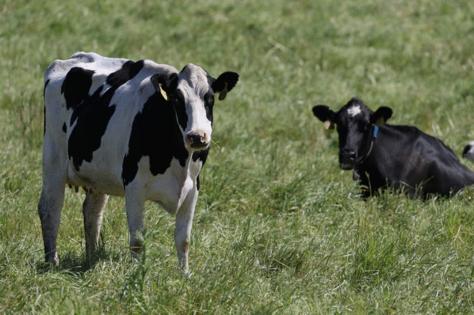US sees third confirmed human bird flu case
Published in Health & Fitness
The Centers for Disease Control and Prevention confirmed Thursday a third human case of bird flu associated with the growing outbreak in dairy cows. But this case is different and worrisome because it’s the first to prompt more traditional influenza-like symptoms in humans, raising concerns of possible further spread and mutation.
The case is the nation’s fourth confirmed A(H5N1) avian influenza case in the U.S. Unrelated to the current dairy outbreaks, a worker in Colorado developed the virus in 2022 after working to depopulate and dispose of infected poultry. That person recovered.
The CDC said a second dairy worker in Michigan developed the disease after exposure to H5N1-infected cows, and at a different farm from the case last week. The latest person reported symptoms to local health officials: upper respiratory tract symptoms, including cough and eye discomfort with watery discharge. The patient didn’t have a fever.
The prior two confirmed human infections did not have upper respiratory tract symptoms but did have conjunctivitis. National health officials emphasized that avian influenzas usually affect respiratory systems. The latest patient is being treated with oseltamivir, the antiviral drug sold under the brand name Tamiflu.
The person is isolating at home and recovering. So far, household contacts of the patient are not showing symptoms but are being monitored for illness. They have also been offered Tamiflu as a preventive. There is no evidence that H5N1 is spreading from person to person, the CDC said.
The newly emerged case does not immediately change the risk for the general public, which remains low, according to the CDC. But the federal agency said they are doing a genetic analysis of the virus sample and will look for any changes in the virus that could change the agency’s risk assessment.
The CDC says it wants states to help make PPE available to all dairy farm workers though the agency stresses the priority is farms with affected herds.
“These cases, both the prior two as well as the latest one, demonstrate the important of PPE,” said CDC Principal Deputy Director Nirav Shah.
As of Thursday, there have been 67 dairy herds across nines with cattle infected by the bird flu, according to the U.S. Agriculture Department. In addition to herds in Michigan, dairy cattle in Colorado, Kansas, Idaho, New Mexico, North Carolina, Ohio, South Dakota and Texas have also tested positive for bird flu.
While Georgia has not yet had a bird flu case associated with the growing outbreak in dairy cows, health and agriculture officials are starting to ramp up efforts to help prevent the spread of avian influenza.
The Georgia Department of Agriculture has received several requests for PPE and is providing it for free to interested farmers as a preventive measure. Agency spokesman Matthew Agvent said the department is working with state health officials to “distribute PPE to interested farmers” upon request.
As of now, no Georgia farms are eligible for the USDA’s PPE reimbursement because the state doesn’t have a confirmed or suspected case, but they can request it from the state Agriculture Department for free.
The CDC credited Michigan’s monitoring and testing strategies for detecting the latest human case. Confirmed cases have been found in dozens of dairy herds across nine states, with Michigan ranking among the most impacted. The state also has the most robust testing participation among farmers and farm workers, with Michigan accounting for the vast majority all people tested for this bird flu strain since the first dairy cow cases were discovered in March, according to Michigan Department of Agriculture Director Tim Boring.
Before the third case was announced Thursday, Boring told The Atlanta Journal-Constitution that high testing cooperation starts at the local level. Michigan agencies have partnered with local officials, dairy and poultry organizations and health nonprofits to send out mailers and daily texts to farms to educate about infection risks and the benefits of PPE.
“There’s a lot of steps here in place to mitigate the spread on the animal side,” Boring said, citing herd tracking and pasteurization as two methods. “But all of this continues to be with the mindfulness that we want to make sure that we’re protecting human health.”
Georgia’s Agriculture Department has its own supply of PPE, which is separate from the emergency preparedness stockpile managed by the Georgia Department of Public Health.
Nancy Nydam, a spokesperson with DPH, said the agency is coordinating with the Georgia Department of Agriculture to identify where to send PPE and fulfill requests for PPE when — and if — needed.
The USDA recently said that over the next 120 days, the agency will provide up to $2,000 per month for dairy farmers “per affected premises” who supply PPE to employees or provide outerwear uniform laundering. These producers must also have their employees participate in a workplace and farmworker study conducted by the USDA and CDC.
Many bird flu experts say PPE — especially face shields and goggles — should be worn by all dairy farm workers as the outbreak continues to grow. Boring said many Michigan farms already employ and use those protective measures, but he said states should “make sure that all of those things are amply available to farms.”
“We’re in a constant state of refining our approaching and learning a little bit more every day and using that to guide public policy” he said.
-------
©2024 The Atlanta Journal-Constitution. Visit at ajc.com. Distributed by Tribune Content Agency, LLC.







Comments